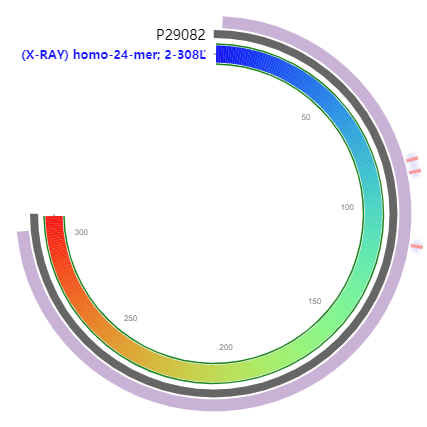Catalyzes the simultaneous oxidation and reduction of elemental sulfur in the presence of oxygen, with sulfite and hydrogen sulfide as products. •
MPKPYVAINMAELKNEPKTFEMFASVGPKVCMVTARHPGFVGFQNHIQIGILPFGNRYGG
AKMDMTKESSTVRVLQYTFWKDWKDHEEMHRQNWSYLFRLCYSCASQMIWGPWEPIYEII
YANMPINTEMTDFTAVVGKKFAEGKPLDIPVISQPYGKRVVAFAEHSVIPGKEKQFEDAI
VRTLEMLKKAPGFLGAMVLKEIGVSGIGSMQFGAKGFHQVLENPGSLEPDPNNVMYSVPE
AKNTPQQYIVHVEWANTDALMFGMGRVLLYPELRQVHDEVLDTLVYGPYIRILNPMMEGT
FWREYLNEQ314

| PMID | Title & Author | Abstract | Year | |
| 0 | 27682113 | Sulfur Oxygenase Reductase (Sor) in the Moderately Thermoacidophilic Leaching Bacteria: Studies in Sulfobacillus thermosulfidooxidans and Acidithiobacillus caldus Claudia Janosch , Francisco Remonsellez , Wolfgang Sand , Mario Vera | The sulfur oxygenase reductase (Sor) catalyzes the oxygen dependent disproportionation of elemental sulfur, producing sulfite, thiosulfate and sulfide. Being considered an "archaeal like" enzyme, it is also encoded in the genomes of some acidophilic leaching bacteria such as Acidithiobacillus caldus, Acidithiobacillus thiooxidans, Acidithiobacillus ferrivorans and Sulfobacillus thermosulfidooxidans, among others. We measured Sor activity in crude extracts from Sb. thermosulfidooxidans DSM 9293(T). The optimum temperature for its oxygenase activity was achieved at 75 °C, confirming the "thermophilic" nature of this enzyme. Additionally, a search for genes probably involved in sulfur metabolism in the genome sequence of Sb. thermosulfidooxidans DSM 9293(T) was done. Interestingly, no sox genes were found. Two sor genes, a complete heterodisulfidereductase (hdr) gene cluster, three tetrathionate hydrolase (tth) genes, three sulfide quinonereductase (sqr), as well as the doxD component of a thiosulfate quinonereductase (tqo) were found. Seven At. caldus strains were tested for Sor activity, which was not detected in any of them. We provide evidence that an earlier reported Sor activity from At. caldus S1 and S2 strains most likely was due to the presence of a Sulfobacillus contaminant. | 2015 |
| 1 | 27920296 | A Sulfur Oxygenase from the Haloalkaliphilic Bacterium Thioalkalivibrio paradoxus with Atypically Low Reductase Activity Patrick Rühl , Uwe Pöll , Johannes Braun , Andreas Klingl , Arnulf Kletzin | Sequence comparisons showed that the sulfur oxygenase reductase (SOR) of the haloalkaliphilic bacterium Thioalkalivibrio paradoxus Arh 1 (TpSOR) is branching deeply within dendrograms of these proteins (29 to 34% identity). A synthetic gene encoding TpSOR expressed in Escherichia coli resulted in a protein 14.7 ± 0.9 nm in diameter and an apparent molecular mass of 556 kDa. Sulfite and thiosulfate were formed from elemental sulfur in a temperature range of 10 to 98°C (optimum temperature ≈ 80°C) and a pH range of 6 to 11.5 (optimum pH ≈ 9; 308 ± 78 U/mg of protein). Sulfide formation had a maximum specific activity of 0.03 U/mg, or <1% of the corresponding activity of other SORs. Hence, reductase activity seems not to be an integral part of the reaction mechanism. TpSOR was most active at NaCl or glycine betaine concentrations of 0 to 1 M, although 0.2% of the maximal activity was detected even at 5 M NaCl and 4 M betaine. The melting point of TpSOR was close to 80°C, when monitored by circular dichroism spectroscopy or differential scanning fluorimetry; however, the denaturation kinetics were slow: 55% of the residual activity remained after 25 min of incubation at 80°C. Site-directed mutagenesis showed that the active-site residue Cys44 is essential for activity, whereas alanine mutants of the two other conserved cysteines retained about 0.5% residual activity. A model of the sulfur metabolism in T. paradoxus is discussed. | 2017 |
Urich T , Bandeiras T M , Sónia S Leal, et al. The sulphur oxygenase reductase from Acidianus ambivalens is a multimeric protein containing a low-potential mononuclear non-haem iron centre[J]. Biochemical Journal, 2004, 381(Pt 1):137-146.